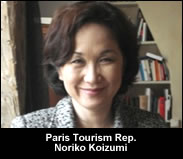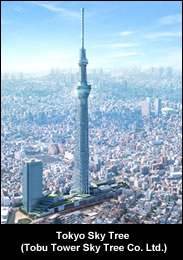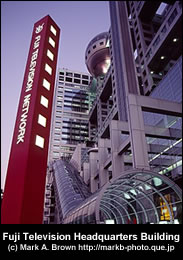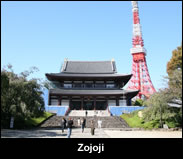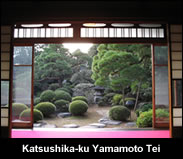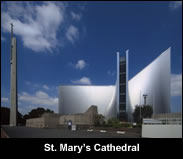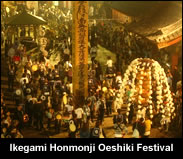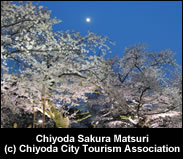
- News & Announcements
- Theme 1: Architectural Wonders in Tokyo
- Theme 2: Experience History
- Event Information
- Did you know? Fun Facts About Tokyo
|
Tokyo is coming to Paris! Narita steps up arrivals and departures Transportation Authorities Increase Multilingual Information
|
|
|
Tokyo's dramatic, ever-changing cityscape is one of the world's most renowned and recognizable. Blending futuristic skyscrapers with classical and historical buildings, Tokyo is an exciting place for architectural explorations. A New Tower on the Horizon http://www.tokyo-skytree.jp/english/design/plaza.html New Additions The resurgent Roppongi area is home to the pioneering Suntory Museum of Art. Designed by Kengo Kuma, it has since been joined by the innovative 21-21 DESIGN SIGHT, designed by Tadao Ando, set against the spectacular backdrop of Tokyo Midtown. One of Ginza's newer, and most intriguing buildings, is the NICOLAS G. HAYEK CENTER. Home to THE SWATCH GROUP (JAPAN) KK's new headquarters and retail shop, it is a building that truly has to be seen to be fully appreciated. A few minutes walk away is the gracefully curving De Beers Ginza Building. Opened in 2008, it has already become one of Ginza's most photographed buildings. Architectural design is by no means limited to commercial spaces. Shibuya station, home to iconic Hachiko Crossing, is one of Tokyo's busiest. However, Tadao Ando's extension to Shibuya station links the Tokyu Toyoko and Tokyo Metro Fukutoshin train lines through a highly original and futuristic underground spaceship design. Even more Architectural Explorations: Some of the most visited modern architectural marvels in Tokyo such as the TOKYO INTERNATIONAL FORUM in Yurakucho, the Fuji Television Headquarters Building in Odaiba and the Asahi Breweries, Ltd. Azumabashi Headquarters Building in Asakusa, combine design with function in ways unique to Tokyo. TOKYO INTERNATIONAL FORUM Resource Links:
|
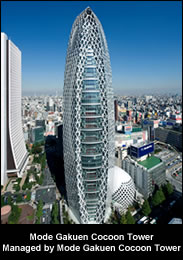
|
|
Architecture in Tokyo is by no means limited to the futuristic or modern. Structures throughout the city represent and remind visitors of a history stretching back centuries. No historical tour of Tokyo can be complete without a visit to Asakusa's Sensoji Temple and it's 5 Story Pagoda. Originally built through the late 7 and early 8 Century these structures are amongst Tokyo's oldest and most visited. Sensoji Dating back to Japan's Muromachi Period (1336-1573), Zojoji Temple in Minato-ku and Sakurada-mon in Chiyoda-ku, represent one of Japan's most interesting periods of architectural development. Zojoji However, it was in the Edo Period (1603-1868) that Tokyo truly came to the fore and it is no surprise that some of Tokyo's most dramatic historical buildings date from this era. The striking Imperial Watchtower (also known as Fushimi Yagura Keep), Kanei-ji Temple and 5 storied Pagoda in Ueno are all prime examples of this architectural tradition. Kanei-ji and 5 storied Pagoda in Ueno With the Meiji Period came the arrival of new architectural philosophies and designs. One of the first to influence the cityscape of Tokyo was Josiah Conder, who not only designed the Mitsubishi Ichigokan Museum, but more importantly taught the first generation of Japanese architects Western style building design in Tokyo. Among his prodigies were Tokuma Katayama, Tatsuzo Sone, and Kingo Tatsuno who would later design the distinctive Tokyo Station and Bank of Japan buildings that are still important landmarks around the city today. Start your Meiji architectural roaming at the reconstructed Mitsubishi Ichigokan Museum; opening in April 2010. Mistubishi Ichigokan Museum, Tokyo One of the most renowned Japanese architects of the modern era, Kenzo Tange is responsible for Tokyo signature structures such as the Tokyo Metropolitan Buildings in Shinjuku, the Yoyogi Olympic Gymnastic Hall and St. Mary's Cathedral. Another famed Japanese architect is Kunio Maekawa, who designed the impressive Tokyo Bunka Kaikan and The National Musuem of Western Art (Main building designed by Le Corbusier), both of which helped to re-define the Tokyo cityscape in the mid 20th Century. Tokyo is, however, not a city where one can only see and not explore. Stepping a little further forward in time, the The Museum of Life in the Showa Era (Showa no Kurashi Hakubutsukan) lets visitors experience a Tokyo from the 1950s-1970s, an era of unprecedented change in the metropolis. These forces are also well-represented in Katsushika-ku Yamamoto Tei (House & Garden) - a rare example of a Western-influenced, Japanese-designed building dating from the late 1950s. Another option is to explore Tokyo's architectural treats on walking tours through areas such as Ginza, Omotesando, Roppongi, Shinjuku or Nihombashi, where participants may take in a mix of historic and modern buildings en route. Ginza Walking tours tend to work up an appetite, but thankfully Tokyo restaurants such as Yabusoba, Isegen, Kanda Matsuya and Takemura all combine delicious cuisine with traditional architecture. Kanda Yabu Soba Other recomendations:
|
|
|
Ikegami Honmonji Oeshiki Festival Tokyo Designer's Week For information on other events:
|
|
|
Did you know... Cherry blossoms along the Chidorigafuchi moat and in Yasukuni Shrine at the Chiyoda Sakura Festival are illuminated at night by LED lights, which conserve more energy and reduce CO2 emissions compared to traditional lights. The cherry blossoms are expected to be out from around the end of March to beginning of April and closest access is via Kudanshita Station. http://kuminseikatsu.city.chiyoda.tokyo.jp/english/e-guide/ |
|
To access the previous edition of e-Tokyo Today and our printed newsletter, Tokyo Today, Issued by: Tourism Division, Bureau of Industrial and Labor Affairs, Tokyo Metropolitan Government |
